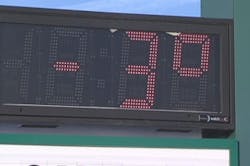Cold Weather Requires All Hands On Deck At Airports
Jan. 23--Jeff Baum sums up the feelings of a lot of folks when he describes the impact of this week's subzero temperatures on the aviation business.
"It's a real pain in the hind end," said Baum, CEO of Wisconsin Aviation, based in Watertown.
From small airports to Mitchell International Airport in Milwaukee, folks across Wisconsin are working outside in freezing cold so travelers can take to the sky and reach their destinations with barely a shiver.
Airplanes don't stop flying just because it's cold outside.
Planes have a love-hate relationship with the weather, Baum said.
"The aircraft perform much better in cold weather than they do in hot weather," Baum said. "The air is much denser when it's cold. The wings create more lift. The propellers generate more thrust and so forth.
"You take some of these icy, crisp, clear winter days and it's an absolute delight to be out there flying."
Reaching the point of being able to take flight is the challenge.
Everything associated with airports has a tough time running in ground temperatures like this.
"We have issues keeping equipment running," said Chris Barbre, manager of ramp and operations for Southwest Airlines at Mitchell International. "It's not just the aircraft. It's the belt loaders and the tugs and the pushback trucks and all our ground support equipment that we have to address."
Early Tuesday, the temperature at Mitchell hit minus 5 with a wind chill of minus 26, according to the National Weather Service.
When it's that cold, Southwest, the market share leader at Mitchell, has to bring on extra people for the overnight shift "just to keep equipment running," Barbre said.
Warm-up crews
You can't let a Boeing 737 idle at the airport all night, but that's close to what happens. Airline crews activate and monitor auxiliary power units to keep the planes warm while they are parked overnight in preparation for the first flights the next day.
"We have to keep the aircraft warm," he said.
When you are parked at a gate and see a yellow-orange hose attached to an aircraft, it is pumping hot air (cold air in summer) into the aircraft. "On nights like (Monday) night, when the air temperature is so cold and the wind is so strong, sometimes we have to supplement that," Barbre said.
Heat is run through the aircraft using the auxiliary power unit, then it is shut down, the aircraft is buttoned up and then monitored all night, Barbre said. The heat slowly dissipates but keeps things such as the plane's potable water system from freezing.
"The key to keeping an airplane ready for operation in cold weather is keeping the airplane warm," Linda Lee, spokeswoman for the 737 program at Boeing said in an email.
"Airplane fluids are kept warm to make sure their viscosities don't change," Lee added. "Certain airplane systems are cycled (moved) to make sure the fluids are warm in the entire system prior to takeoff."
The planes are built to perform in high altitudes where the temperatures are frigid. Boeing airplanes operate continuously in low temperatures down to minus 65 degrees Fahrenheit, Lee said.
If it snows, things get even more complicated for air travel. (The weather service says snow is likely Thursday night and Friday morning in Milwaukee.)
Training for winter
Crews at Integrated Deicing Services begin preparing in September for winter, said Patrick Brown, vice president of sales and marketing for the company.
"We spend a lot of time in the summer gearing up for the wintertime," he said. "We're prepared for the worst weather.
"That's when the adrenaline gets rocking," he added.
All of Integrated Deicing's crews work in enclosed cabs on the de-icing trucks, Brown said.
The cold weather brings headaches beyond hangars, gates and tarmacs.
Parking services at Mitchell in Milwaukee are running two trucks around the clock to jump-start vehicles whose owners return from trips to find their car batteries are dead. Where the airport might see about 10 jump-starts on an average day, the figure soars to 80 to 100 on extremely cold days.
The airport tries to reach stranded parking lot patrons within 20 minutes, and if crews are delayed reaching them, they are advised to seek shelter back at the terminal, said Jeff Trapp, airport operations manager for Central Parking Systems.
Rescue gear checked
At the airport Fire Department, fire and rescue equipment is checked around the clock to make sure it will start and function in an emergency, no matter how cold it is outside. The department's massive crash response trucks have built-in heaters to keep the 3,000 gallons of water as well as foam and other fire-extinguishing materials on board from freezing.
Airport fire crews have held safety briefings the past two days to remind firefighters about handling the cold.
"We really have to watch our people," said Assistant Chief David Meyers. "Hypothermia sets in quickly."
A priority in a rescue situation is to get sick or injured people into shelter and away from the cold as quickly as possible.
"The big thing here is to get people out of the elements," said Jeff Birmingham, an airport firefighter. "We train for this all the time."
Copyright 2013 - Milwaukee Journal Sentinel
